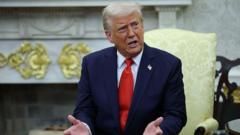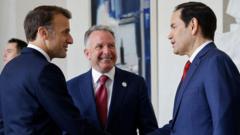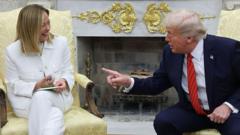The European Union is navigating a complex trade landscape as it responds to President Trump's aggressive trade policies. With offers to eliminate tariffs on U.S. goods, EU leaders face the challenge of asserting strength while avoiding escalation in the trade conflict.
Europe's Strategic Gamble in Response to Trump's Trade Policies

Europe's Strategic Gamble in Response to Trump's Trade Policies
In a bold move, the EU balances offers of negotiation with potential retaliatory tariffs, challenging the U.S. amidst escalating trade tensions.
The European Union (EU) is stepping into the trade conflict initiated by President Trump's administration with a dual approach, presenting both incentives for cooperation and the threat of retaliatory tariffs on U.S. products. As tensions rise, the question arises: can Europe's strategy effectively balance negotiation and a show of resilience in the face of aggression?
Ursula von der Leyen, the president of the European Commission, has extended a negotiating hand by proposing to eliminate tariffs on American automobiles and other industrial goods, offering a "zero-for-zero" deal if the U.S. reciprocates. This offer aims to soothe the U.S. administration while also preparing a response to the recently announced tariffs that Trump has imposed, which include a 20 percent levy across the board on EU imports and even steeper tariffs on steel, aluminum, and vehicles.
Experts express mixed opinions about the effectiveness of this strategy. Michael Strain of the American Enterprise Institute remarked that while Europe has the capability to inflict economic pain on the U.S., it remains uncertain if Trump is receptive to the potential political consequences that might emerge domestically.
On the other side, Trump has signaled a hard stance against nations that retaliate against his tariffs, notably by threatening increased levies on Chinese goods amidst his focus on providing preferential treatment to countries allied with the U.S., such as Japan.
As the EU moves forward, the weight of its decision rests on whether its approach of wielding both incentives and potential economic backlash will yield a favorable outcome, or if a show of strength may ultimately backfire in the face of a resolute U.S. trade policy championing protectionism.






















